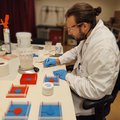 Awesome awesome
Awesome awesome
 Yes, a transcript will be posted right after the chat!
Yes, a transcript will be posted right after the chat!
![]() Have you ever tried out methacrylate and a photomask to make molds? It seemed to be in vogue for a while but I found it pretty tough to work with
Have you ever tried out methacrylate and a photomask to make molds? It seemed to be in vogue for a while but I found it pretty tough to work with
 Lol, I never thought people would come to me for PDMS hookups
Lol, I never thought people would come to me for PDMS hookups
![]() You're our new plug
You're our new plug
 @isaac no I never heard of methacrylate, but a quick wiki is telling me that it's gonna be a pain
@isaac no I never heard of methacrylate, but a quick wiki is telling me that it's gonna be a pain
![]() Anyone put much effort into frequency tuning a tesla valve?
Anyone put much effort into frequency tuning a tesla valve?
 not here, though this conversation has me all motivated about testing with tesla valves!
not here, though this conversation has me all motivated about testing with tesla valves!
![]() I was an hour off on the start time. Bummer. I had some questions regarding surfaces textured with tesla valves.
I was an hour off on the start time. Bummer. I had some questions regarding surfaces textured with tesla valves.
 @kdharbert what do you mean by frequency tuning ?
@kdharbert what do you mean by frequency tuning ?
 I did microfluidics once but it was the other way around (from the IGEM approach ) casting PDMS liquid on a plate with electrospun protrusions to make a cast. Then glue it to a glass plate (with UV epoxy??) and poke holes in the PDMS with tubes, then add tubes for inflow outflow. This was for microscopy. Is this still done or are there easier ways, as the Igem methods, with the same benefits.
I did microfluidics once but it was the other way around (from the IGEM approach ) casting PDMS liquid on a plate with electrospun protrusions to make a cast. Then glue it to a glass plate (with UV epoxy??) and poke holes in the PDMS with tubes, then add tubes for inflow outflow. This was for microscopy. Is this still done or are there easier ways, as the Igem methods, with the same benefits.
![]() According to what I've seen the diodicity increases with higher frequency
According to what I've seen the diodicity increases with higher frequency
 If you need a reminder email for the Hack CHat, sign up here: http://eepurl.com/cDE5-H
If you need a reminder email for the Hack CHat, sign up here: http://eepurl.com/cDE5-H
![]() it drops at a low frequency, hence 'slightly leaky'
it drops at a low frequency, hence 'slightly leaky'
 Sends out a reminder 30 minutes before each chat
Sends out a reminder 30 minutes before each chat
 Also here are my Shameless plugs:
Also here are my Shameless plugs:
Check out the interactive design tool: https://3duf.org
Stay tuned for a microfluidic hardware description language I'm working on called: LFR (Liquid Flow Relationships) (supported by https://neptune.fluigicad.org)
If you’re doing Academic microfluidics, check out my colleague’s CNC milling paper: https://link.springer.com/article/10.1007/s10404-018-2048-2
Some open source efforts we are putting together for Microfluidics : https://distributeddiagnostics.org/
Chat more about open source microfluidics and join the small community we have on this and look at what we putting together: https://join.slack.com/t/dist-diag/shared_invite/zt-rci22g8h-JnzoZw7liJwFilAFoKu_jg
![]() I suspect they can be shaped to manipulate frequency response.
I suspect they can be shaped to manipulate frequency response.
![]() What substrate do you use for the channels when milling? Acrylic?
What substrate do you use for the channels when milling? Acrylic?
 @kdharbert yeah I'm pretty sure they would have a frequency response since most of the cases I considered only continuous flow, so I never thought about that. It should be possible to characterize it though
@kdharbert yeah I'm pretty sure they would have a frequency response since most of the cases I considered only continuous flow, so I never thought about that. It should be possible to characterize it though
![]() If so, any tips on small channels? I've got a 1/100" bit ready to go but I've been to nervous to try it out haha
If so, any tips on small channels? I've got a 1/100" bit ready to go but I've been to nervous to try it out haha
 We're at the top of the hour, and while I hate to break off a cool discussion, we have to give Krishna the opportunity to sign off if he needs to. Of course the Hack Chat is always open, so feel free to stay on and keep the conversation going.
We're at the top of the hour, and while I hate to break off a cool discussion, we have to give Krishna the opportunity to sign off if he needs to. Of course the Hack Chat is always open, so feel free to stay on and keep the conversation going.
I'll just put the official wrap on this chat with a big thanks to Krishna for his time today, and to everyone for a great discussion. Thanks all!
 @isaac we have all the settings for Polycarbonate, and all the methodologies, characterization / test files if you want to figure out the feeds and speeds for acrylic or any other material
@isaac we have all the settings for Polycarbonate, and all the methodologies, characterization / test files if you want to figure out the feeds and speeds for acrylic or any other material
![]() @rkrishnasanka Right, once that is dealt with vibration at the right frequency should be able to drive fluid uphill.
@rkrishnasanka Right, once that is dealt with vibration at the right frequency should be able to drive fluid uphill.
 @isaac 1/100 is super easy, its what they let me mill with, in the lab :P (I'm not allowed to use the <100um endmills)
@isaac 1/100 is super easy, its what they let me mill with, in the lab :P (I'm not allowed to use the <100um endmills)
 I should be online for a little longer if you all have any more questions, easiest way to get to me is the Distributed Diagnostics Slack.
I should be online for a little longer if you all have any more questions, easiest way to get to me is the Distributed Diagnostics Slack.
 Also a friend sen me this once. Might be interesting for people to get inspired doing Microfluidics DIY: https://www.science-practice.com/blog/2015/01/29/low-tech-microfluidics/
Also a friend sen me this once. Might be interesting for people to get inspired doing Microfluidics DIY: https://www.science-practice.com/blog/2015/01/29/low-tech-microfluidics/
![]() Ah thats good to hear. I'm going to chuck it up and send it then
Ah thats good to hear. I'm going to chuck it up and send it then
 What is lacking is a general cad framework for all these specialty areas where we could pass the data around the diferent modules... Something like eplan, but on steroids... it would be a mean stack for automating and teaching pratical engineering, managing projercts and labs...
What is lacking is a general cad framework for all these specialty areas where we could pass the data around the diferent modules... Something like eplan, but on steroids... it would be a mean stack for automating and teaching pratical engineering, managing projercts and labs...
 @Andre Esteves establishing the CAD framework is the goal of my Ph.D I'd love to hear more about what you (and the rest of the community) think the gaps are. I suspect that I've addressed a whole of the issues. With the help of the community, I think we can definitely bridge the gap. Thats one of the reasons why we wanted to start Distributed Diagnostics, to gather the entire community.
@Andre Esteves establishing the CAD framework is the goal of my Ph.D I'd love to hear more about what you (and the rest of the community) think the gaps are. I suspect that I've addressed a whole of the issues. With the help of the community, I think we can definitely bridge the gap. Thats one of the reasons why we wanted to start Distributed Diagnostics, to gather the entire community.
 @Andre Esteves is this like a grammar for designing those devices, i.e. a language based way to describe a device so it becomes easily reproducible (in its parts)??
@Andre Esteves is this like a grammar for designing those devices, i.e. a language based way to describe a device so it becomes easily reproducible (in its parts)??
 Dan Maloney
Dan Maloney
Discussions
Become a Hackaday.io Member
Create an account to leave a comment. Already have an account? Log In.